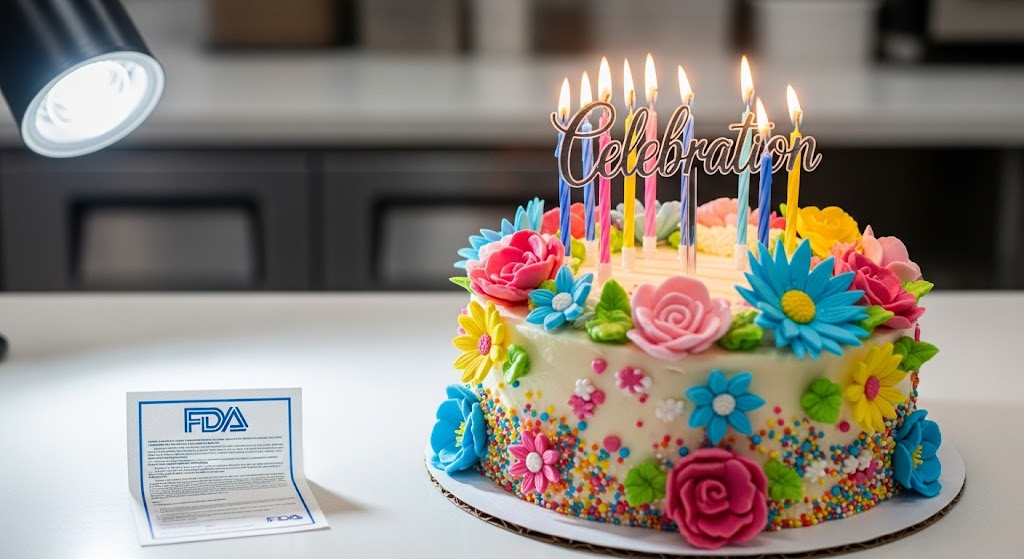In the vibrant and creative world of baking and confectionary arts, dessert decoration safety is paramount. The artistry seen on everything from elaborate wedding cakes to simple, home-baked cupcakes has elevated these treats to the status of high-priced works of art. While the focus is often on the aesthetic appeal, the health and safety of consumers is a non-negotiable priority. Beyond the ingredients of the cake itself, this extends to the many items used for ornamentation. This document will serve as an in-depth guide for manufacturers, bakers, and caterers, providing essential information on the regulations and best practices required to ensure that all edible dessert decorations and inedible dessert decorations are compliant, clean, and non-hazardous. We will explore the critical role of the FDA and the specific challenges posed by a wide variety of materials.
Understanding FDA Food Regulations for Dessert Decorations
The U.S. Food and Drug Administration (FDA) is the governing body responsible for ensuring the safety of food products sold in the United States. A common misconception is that inedible items are exempt from these regulations. However, the FDA’s Center for Food Safety and Applied Nutrition (CFSAN) division explicitly regulates all items that come into contact with food, including those not meant for consumption.
- Dessert Decorations as Food Products: Under FDA food regulations, any item—whether it is a plastic cake topper, a celebratory candle, or a metal wire used in a sugar flower—that touches a food product is considered a food-contact substance. This classification requires manufacturers to ensure these items are safe for their intended use and do not pose a risk of contamination.
- The Responsibility of Manufacturers: This means that producers of party goods, novelty items, and other decorative products must adhere to the same stringent safety standards as food manufacturers. They must verify that their products are free of toxic substances, that their materials will not migrate into the food, and that they are manufactured under sanitary conditions.
A Closer Look at Edible vs. Inedible Decorations
The distinction between edible and inedible items is crucial for managing safety risks. While both are regulated, they present different sets of challenges.
Edible Dessert Decorations
These are products intended for consumption, such as sugar candies, fondant figures, sprinkles, and even fresh flowers. Their primary safety concern lies in the ingredients themselves.
|
Decoration Type |
Key Safety Considerations |
|---|---|
|
Sugar Flowers/Shapes |
Use of food-grade dyes, safe ingredients, and proper storage. |
|
Sprinkles & Candies |
Food allergen controls and clear labeling of all ingredients. |
|
Fresh Flowers |
Sourcing from a food-safe grower, ensuring no pesticides or toxins. |
Inedible Dessert Decorations
This category includes items like plastic toppers, candles, ceramics, fabrics, and metal wires. The danger here is not in their consumption but in the potential for physical or chemical contamination.
- Chemical Hazards: Materials like certain plastics, metals, and fabrics may contain chemicals (e.g., BPA, lead, or synthetic dyes) that can leach into the food, especially when exposed to moisture, oils, or acids found in baked goods.
- Physical Hazards: Poorly constructed or low-quality decorations can shed small pieces, creating a choking hazard. Examples include glitter, small plastic parts, or broken ceramic fragments.
- Contamination Risks: Because many of these products are not made in a food-safe environment, they can introduce microbial or other contaminants to the food surface if not handled and cleaned properly.
Best Practices for Ensuring Compliance and Safety
For anyone involved in the production or use of dessert decorations, a proactive approach to safety and compliance is essential.
Sourcing and Manufacturing
- Demand Proof of Compliance: Manufacturers should be prepared to provide documentation that their products meet FDA standards. This includes information on the materials used, their manufacturing processes, and any relevant safety certifications.
- Material Selection: Choose materials that are known to be food-safe. For plastics, this means using a food-grade resin that is free of hazardous chemicals. For other materials, it means sourcing from suppliers who specialize in food-contact items.
Handling and Sanitation
- Cleanliness is Key: Regardless of the item’s intended use, all decorations that will come into contact with food should be handled with the same sanitary rigor as the food itself. This includes proper handwashing and using clean tools.
- Sanitization Procedures: For reusable inedible dessert decorations like baker’s tools or cake toppers, establish a clear sanitation procedure. This may involve washing with food-safe detergents or, if appropriate, using a commercial dishwasher.
The Future of Food Safety and Decoration
As the dessert industry continues to innovate, the challenges of dessert decoration safety will also evolve. The FDA’s regulations provide a clear framework, but it is ultimately the vigilance of manufacturers, bakers, and caterers that protects the consumer. By prioritizing compliance and adopting best practices in sourcing and handling, the industry can continue to create stunning, safe, and delicious desserts.
Frequently Asked Questions on Dessert Decoration Safety
The FDA considers any inedible dessert decorations that come into contact with food to be “food-contact substances.” Therefore, they are regulated under FDA food regulations and must be proven to be safe, clean, and non-hazardous.
Baker’s tools, such as spatulas or molds, can pose risks if they are not made from food-safe materials or are not properly cleaned. Poorly maintained or non-food-grade tools can transfer chemicals or bacteria to the food.
A baker should request documentation from their supplier proving that the decorations meet U.S. FDA food regulations. This includes information on the materials used, manufacturing processes, and any third-party safety certifications.
No. Only food-safe or edible flowers should be used. Many ornamental flowers are treated with pesticides or are naturally toxic. It is essential to source flowers specifically from growers who cultivate them for food use to ensure their safety.

